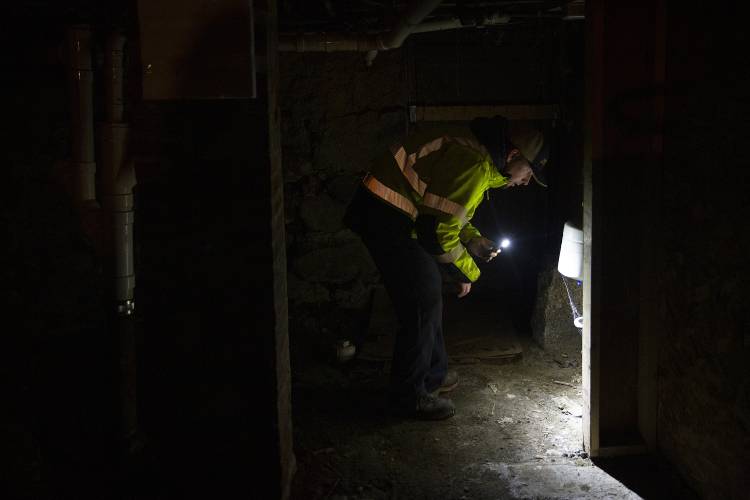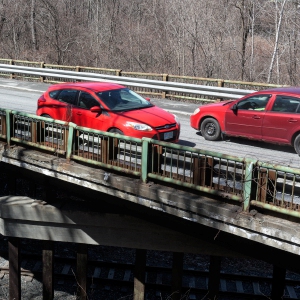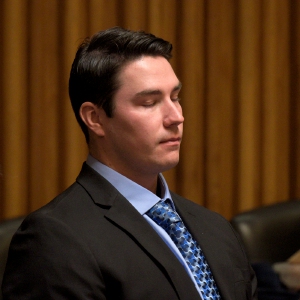Childhood lead exposure rates increase in NH, even as Upper Valley municipalities work to reduce it

Seth Martin, utilities maintenance operator with the Lebanon Public Works Department, checks a water service line to determine what material it is made of in a residential basement in Lebanon, N.H., on Friday, Jan. 19, 2024. Public works employees have been checking service lines around the city as part of an Environmental Protection Agency mandate to identify lead in municipal waterlines and create a plan for remediation. (Valley News / Report For America - Alex Driehaus) Copyright Valley News. May not be reprinted or used online without permission. Send requests to permission@vnews.com. Valley News file — Alex Driehaus
| Published: 03-29-2025 2:01 PM |
LEBANON — New data released by the New Hampshire Department of Health and Human Services has raised red flags about childhood lead exposure in the state.
A December report found that the number of children under 6 years old with elevated levels of lead in their blood in 2023 was the highest that it has been in five years. Childhood lead rates are comparably high in Vermont.
Lead exposure is extremely dangerous especially to young children and can cause long-term brain and nervous system damage, according to the federal Centers for Disease Control and Prevention.
Amid this rise in the number of children displaying elevated blood lead levels, Upper Valley municipalities are continuing work to eliminate lead from water systems and older homes. At the same time, state legislators killed two related bills in early March.
In October, the U.S. Environmental Protection Agency updated its lead and copper rules to require water systems across the country to replace all lead service lines, or the pipes that carry water from the city’s water main to a property, by 2037. Starting in 2027, municipalities must replace about 10% of lead lines annually.
Lead pipes, faucets and plumbing fixtures can contribute to the heavy metal seeping into drinking water through corrosion.
In about two years of surveying both city and privately-owned water connections, the Lebanon Department of Public Works has found no lead water service lines in Lebanon, but galvanized iron lines that may have lead components also must be replaced.
The city has identified 126 galvanized lines so far and has about 1,100 connections left to survey, Public Works Director Jay Cairelli said at a City Council meeting March 19.
Article continues after...
Yesterday's Most Read Articles
 Federal judge temporarily reinstates legal status for Dartmouth graduate student
Federal judge temporarily reinstates legal status for Dartmouth graduate student
 West Lebanon bridge reopens to vehicles
West Lebanon bridge reopens to vehicles
 Former Dartmouth ski team member dies in accident in California
Former Dartmouth ski team member dies in accident in California
 Upper Valley Tesla owners among those rethinking their purchases
Upper Valley Tesla owners among those rethinking their purchases
 Prosecutors seek prison term of at least 30 years for man convicted at Dartmouth rape trial
Prosecutors seek prison term of at least 30 years for man convicted at Dartmouth rape trial
 Upper Valley donut maven Muriel Maville dies at 87
Upper Valley donut maven Muriel Maville dies at 87
Lebanon has to identify the remaining lines before 2027, “so we don't dig up areas we don’t need,” Cairelli said. Until they are identified they are presumed to be in need of replacement.
Each line costs about $15,000 to replace. The portion of pipe running from the water main up to the meter is owned by the city and the property owner is responsible for the portion that runs from the meter to the taps.
At the March 19 meeting, the council granted Cairelli and City Manager Shaun Mulholland permission to apply for a $2.31 million loan from the Drinking Water State Revolving Loan fund to continue identifying and replacing lead water pipes.
“We know we have to do it, we’re already being told this is the best deal we’re going to get, so all very compelling reasons to take advantage of this if we can,” Cairelli told councilors.
At the City Council meeting, Cairelli reported that the state is offering 71% forgiveness for loans awarded this year. The forgiveness rate for future applicants will go down by 5% every year. Cairelli said he has been in talks with the Department of Environmental Services and expects the application to be approved.
The replacement cost after loan forgiveness will be divided between the city (which will raise its share through water rates) and property owners who will each be on the hook for about $2,175, Cairelli said. Residents can also decline to replace their portion, but will be notified every year about potential lead exposure.
The Department of Public Works’ goal is to finish identifying the remaining pipes this summer, Cairelli said.
Nationwide, 15% of childhood lead poisoning is caused by exposure to lead in drinking water, but a much greater portion (70%) comes from “lead paint and dust in housing,” according to the December DHHS report.
In spite of this statistic and in spite of the region’s aging housing stock, Alice Ely, executive director of the Public Health Council of the Upper Valley, said people don’t often discuss the issue of lead paint in homes.
The Public Health Council identifies lead poisoning as one of its priority health concerns. Ely said she does not think that people are very aware of the risks of lead exposure, or believe that it is “happening to somebody else’s kids.”
In general, Ely said she would like to see communities address lead risk collectively because it is wide-reaching, can be expensive to manage and resources are limited. One effort Ely lauded as a strong example of “collective ownership” is Claremont’s Get the Lead Out initiative.
Eighty percent of Claremont’s occupied housing stock was built before 1978, when the federal government banned lead paint. The city is considered a high risk town for childhood lead exposure. When then-Mayor Charlene Lovett learned this in 2016, she started the Get the Lead Out Initiative.
The Claremont team was instrumental in addressing and mitigating childhood lead exposure both in the city and state-wide, including by successfully leading the effort to pass legislation requiring all children to be tested for lead poisoning at 1 and 2 years old, creating a policy to test all children entering the school district, and working with Sullivan County administration to establish a lead paint abatement program.
Lovett has stayed involved with lead remediation efforts in New Hampshire and was recently following House Bill 724, which she hoped would “pivot from identifying childhood poisoning to preventing it.” The House of Representatives killed this and a similar bill in early March.
HB 724, postponed indefinitely, would have addressed lead exposure in several different ways. This included lowering the threshold for a problematic concentration of lead in a child’s blood, requiring the DHHS to inspect all of the units in a housing complex if one has a lead hazard and, if identified, requiring property owners to remediate lead hazards.
State Rep. Wayne MacDonald, R-Rockingham, cited “a significant expense for landlords without resolving the issue of lead poisoning and remediation” as reason to indefinitely postpone the bill, meaning the issue cannot be addressed again this year or next.
State Rep. Mary Hakken-Phillips, D-Hanover, co-wrote HB 724 and co-sponsored it with Sen. Sue Prentiss, D-Lebanon. She described the bill’s defeat as “just really sad.” Hakken-Phillips said while the bill may impose a cost on landlords, this would be a much lower cost than what communities put into schools, health care and other support for children with severe lead poisoning.
“I don’t even have kids, I don’t have rental properties, I really have no (stake) in this except that I know there’s kids in the state we could be saving from lead poisoning and we could probably save our community some money in the aftermath,” Hakken-Phillips said.
The second bill, House Bill 756, would have created a statewide lead testing requirement for children entering child care or public school.
Speaking on the House floor, Rep. Jim Kofalt, R-Hillsborough, a member of the Health, Human Services and Elderly Affairs committee, called the second bill “unnecessary and burdensome” because of the existing universal testing requirement. DHHS data shows that in 2023 70% of 1 year olds and 63% of 2 year olds were tested.
Lovett was a driving force behind the legislation that requires all 1- and 2-year-olds to be screened for blood lead levels at pediatric checkups. She said while this legislation increased screening rates, “we’re still not where we want to be.”
Clare Shanahan can be reached at cshanahan@vnews.com or 603-727-3216.






 Upper Valley businesses feel the sting of rising cocoa prices
Upper Valley businesses feel the sting of rising cocoa prices New Hampshire House passes slimmed-down budget, as Ayotte vows to restore some cuts
New Hampshire House passes slimmed-down budget, as Ayotte vows to restore some cuts Board schedules revote on bond for Bethel and Royalton schools
Board schedules revote on bond for Bethel and Royalton schools
